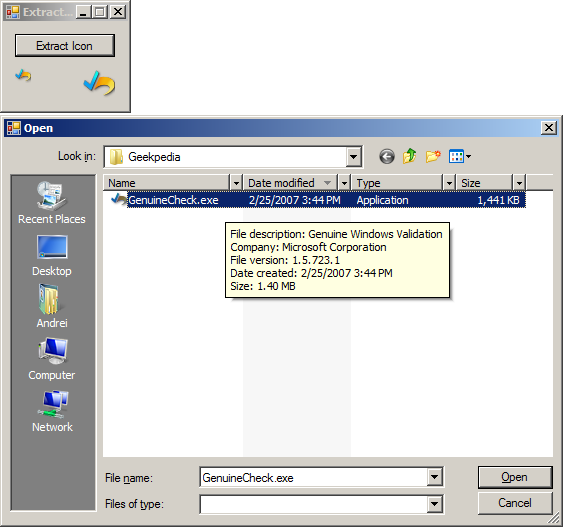In this C# tutorial you will learn how to extract the graphic icon from a file by using a Shell32.dll API call to the unmanaged method SHGetFileInfo().
With this tutorial we’re touching the unmanaged code of Windows again since we’re going to use the SHGetFileInfo() API function. First let’s add the needed reference to InteropServices:
using System.Runtime.InteropServices;A bunch of constants we will use in the call to SHGetFileInfo() to specify the size of the icon we wish to retrieve:
// Constants that we need in the function call
private const int SHGFI_ICON = 0x100;
private const int SHGFI_SMALLICON = 0x1;
private const int SHGFI_LARGEICON = 0x0;The SHFILEINFO structure is very important as it will be our handle to various file information, among which is the graphic icon.
// This structure will contain information about the file
public struct SHFILEINFO
{
// Handle to the icon representing the file
public IntPtr hIcon;
// Index of the icon within the image list
public int iIcon;
// Various attributes of the file
public uint dwAttributes;
// Path to the file
[MarshalAs(UnmanagedType.ByValTStr, SizeConst = 256)]
public string szDisplayName;
// File type
[MarshalAs(UnmanagedType.ByValTStr, SizeConst = 80)]
public string szTypeName;
};The final preparation for the unmanaged code is to define the signature of SHGetFileInfo, which is located inside the popular Shell32.dll:
// The signature of SHGetFileInfo (located in Shell32.dll)
[DllImport("Shell32.dll")]
public static extern IntPtr SHGetFileInfo(string pszPath, uint dwFileAttributes, ref SHFILEINFO psfi, int cbFileInfo, uint uFlags);
Now that we have everything prepared, it's time to make the call to the function and display the icon that we retrieved. The object that will be retrieved is an Icon type (System.Drawing.Icon) but we want to display it in a PictureBox so we'll convert the Icon to a Bitmap using the ToBitmap() method.
But first of all there are 3 controls you need to add to the form, a Button btnExtract that has "Extract Icon" for its Text property, picIconSmall which is a PictureBox and a picIconLarge which is also a PictureBox. That's because we will get two icons sizes. Now double click btnExtract in Visual Studio's Design view and you'll get to its Click event. Inside it is the rest of the code:private void btnExtract_Click(object sender, EventArgs e)
{
// Will store a handle to the small icon
IntPtr hImgSmall;
// Will store a handle to the large icon
IntPtr hImgLarge;
SHFILEINFO shinfo = new SHFILEINFO();
// Open the file that we wish to extract the icon from
if(openFile.ShowDialog() == DialogResult.OK)
{
// Store the file name
string FileName = openFile.FileName;
// Sore the icon in this myIcon object
System.Drawing.Icon myIcon;
// Get a handle to the small icon
hImgSmall = SHGetFileInfo(FileName, 0, ref shinfo, Marshal.SizeOf(shinfo), SHGFI_ICON | SHGFI_SMALLICON);
// Get the small icon from the handle
myIcon = System.Drawing.Icon.FromHandle(shinfo.hIcon);
// Display the small icon
picIconSmall.Image = myIcon.ToBitmap();
// Get a handle to the large icon
hImgLarge = SHGetFileInfo(FileName, 0, ref shinfo, Marshal.SizeOf(shinfo), SHGFI_ICON | SHGFI_LARGEICON);
// Get the large icon from the handle
myIcon = System.Drawing.Icon.FromHandle(shinfo.hIcon);
// Display the large icon
picIconLarge.Image = myIcon.ToBitmap();
}
}
It’s pretty much self explanatory with all the comments, but if you have questions, you can always leave a comment. Here’s the Icon Extractor application in action:

Below is the full source code of the application. You can also download this in a Visual Studio 2005 solution using the link at the top of the tutorial.
using System;
using System.Collections.Generic;
using System.ComponentModel;
using System.Data;
using System.Drawing;
using System.Text;
using System.Windows.Forms;
using System.Runtime.InteropServices;
namespace ExtractIcon
{
public partial class Form1 : Form
{
// Constants that we need in the function call
private const int SHGFI_ICON = 0x100;
private const int SHGFI_SMALLICON = 0x1;
private const int SHGFI_LARGEICON = 0x0;
// This structure will contain information about the file
public struct SHFILEINFO
{
// Handle to the icon representing the file
public IntPtr hIcon;
// Index of the icon within the image list
public int iIcon;
// Various attributes of the file
public uint dwAttributes;
// Path to the file
[MarshalAs(UnmanagedType.ByValTStr, SizeConst = 256)]
public string szDisplayName;
// File type
[MarshalAs(UnmanagedType.ByValTStr, SizeConst = 80)]
public string szTypeName;
};
// The signature of SHGetFileInfo (located in Shell32.dll)
[DllImport("Shell32.dll")]
public static extern IntPtr SHGetFileInfo(string pszPath, uint dwFileAttributes, ref SHFILEINFO psfi, int cbFileInfo, uint uFlags);
public Form1()
{
InitializeComponent();
}
private void btnExtract_Click(object sender, EventArgs e)
{
// Will store a handle to the small icon
IntPtr hImgSmall;
// Will store a handle to the large icon
IntPtr hImgLarge;
SHFILEINFO shinfo = new SHFILEINFO();
// Open the file that we wish to extract the icon from
if(openFile.ShowDialog() == DialogResult.OK)
{
// Store the file name
string FileName = openFile.FileName;
// Sore the icon in this myIcon object
System.Drawing.Icon myIcon;
// Get a handle to the small icon
hImgSmall = SHGetFileInfo(FileName, 0, ref shinfo, Marshal.SizeOf(shinfo), SHGFI_ICON | SHGFI_SMALLICON);
// Get the small icon from the handle
myIcon = System.Drawing.Icon.FromHandle(shinfo.hIcon);
// Display the small icon
picIconSmall.Image = myIcon.ToBitmap();
// Get a handle to the large icon
hImgLarge = SHGetFileInfo(FileName, 0, ref shinfo, Marshal.SizeOf(shinfo), SHGFI_ICON | SHGFI_LARGEICON);
// Get the large icon from the handle
myIcon = System.Drawing.Icon.FromHandle(shinfo.hIcon);
// Display the large icon
picIconLarge.Image = myIcon.ToBitmap();
}
}
}
}


